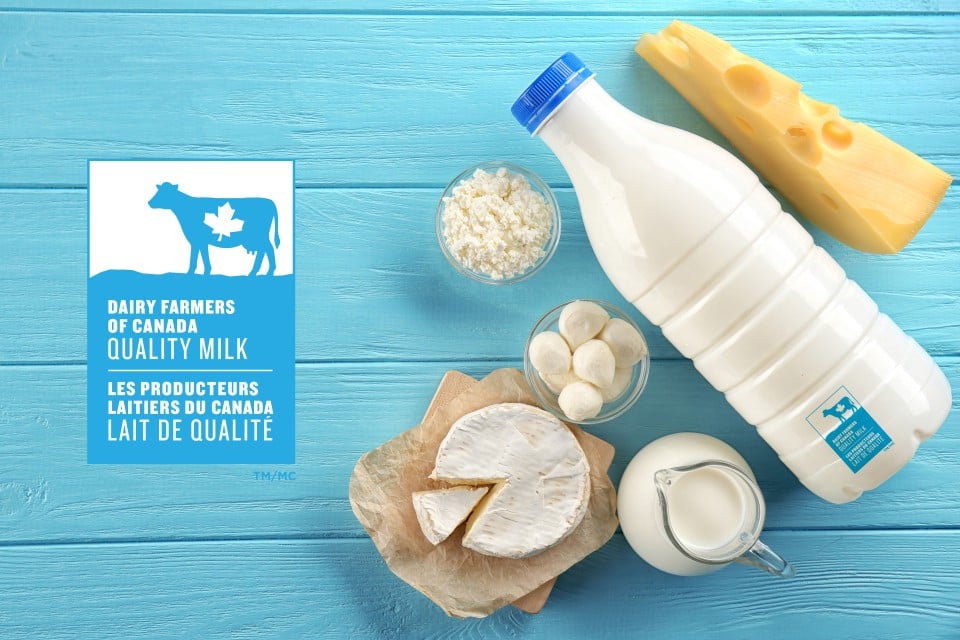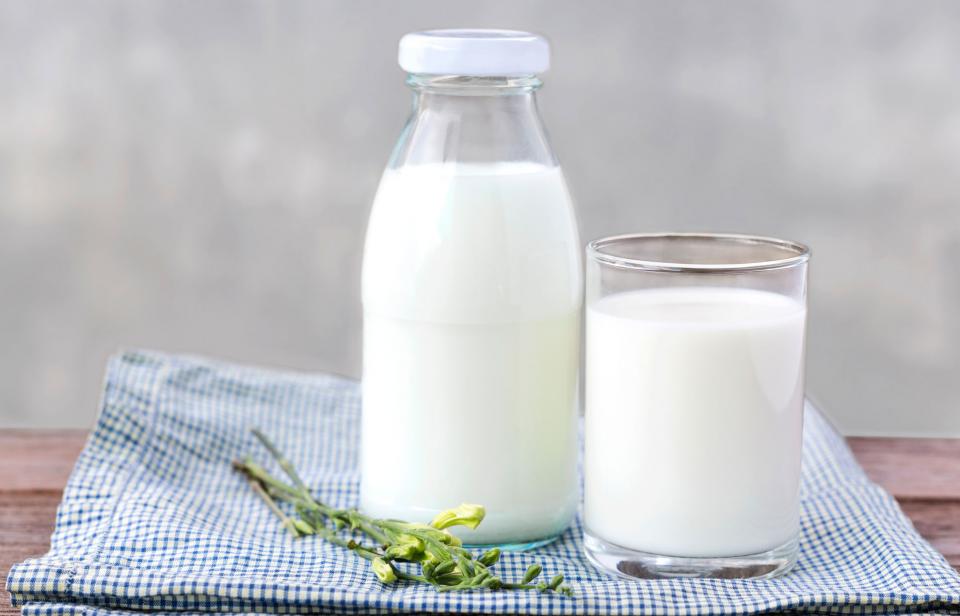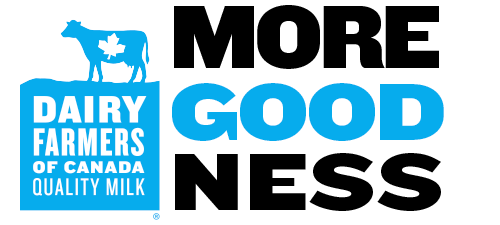Highlights
- In Canada, strict regulations spell out how all milk is tested to verify there is no trace of antibiotics – and that's just the beginning
- The Blue Cow logo guarantees a product is made with 100% Canadian milk and milk ingredients
Did you know that the Canadian milk on your store shelves was tested because it cannot enter the food supply with antibiotics in it? Here are eight reasons to put your mind—and mouth—at ease with 100% Canadian milk:
1. Canadian milk is sampled, traceable and tested.
Your milk truck drivers act as so much more than just chauffeurs going from point A to point B. Each milk truck driver is also a qualified milk grader trained to inspect the sight and smell of milk, as well as take sterile samples from each farmer’s bulk tank before loading it onto the truck.

The samples taken serve several purposes. Chief among them is that it facilitates tracing back to the farm if milk from a certain truck—carrying milk from multiple farms—is found to contain antibiotics. Before unloading at the plant, the processor will test the milk to ensure that only milk which meets Canadian standards is entered for processing.

Out of an approximate 2.2 million milk pickups at farms in Canada each year, less than 0.009 percent turn up positive for antibiotics. On the rare occasion where milk tests positive for antibiotics, the whole truckload is discarded, long before hitting the store shelves. Each step of the way, Canadian milk is under the care and professional supervision of qualified individuals.
To prevent recurrences, there are repercussions to producing even the faintest amount of tainted milk. Farmers responsible for sending off tainted milk must incur the costs of producing the milk as well those for the whole truckload and face a severe penalty. In the rare event that there are several infractions, farmers have their license revoked.
2. Canada maintains strict and lengthy withdrawal times for sick cows.
Like all living beings, cows can fall ill. When this happens, it is the dairy farmers’ and veterinarian’s duty to provide treatment when warranted, following strict guidelines on the use of antibiotics.
The cow receiving antibiotic treatment has a physiological need to continue to be milked. However, her milk is diverted in a separate container and discarded immediately, for as long as it takes the cow to metabolize the antibiotics. This is called the withdrawal period. (Meanwhile, the milk of healthy cows goes directly from udder into a refrigerated bulk tank.) This withdrawal period is established by Health Canada, which in many cases enforces more stringent and cautious regulations than other countries.

3. No antibiotics in Canadian milk – that’s the law.
In Canada, all milk is tested for antibiotic residue before the processing plant is able to accept it. In fact, the Canadian Food Inspection Agency (CFIA) and provincial regulators oversee the analyses that are so sensitive they can measure in parts per billion – equivalent to detecting a single drop of antibiotic residue in an Olympic-size swimming pool. How’s that for peace of mind?

4. Canadian dairy farmers work under the close supervision of veterinarians.
Canadian dairy farmers work closely with veterinarians to manage the health and wellbeing of dairy animals, while preventing sickness. In fact, it is a prerequisite for all Canadian dairy farmers to prove they work closely with a veterinarian before selling their milk. Farmers are required to permanently record all incidents of illness to provide a more holistic overview of the health of their cattle. Only a veterinarian can prescribe antibiotics. Farmers can of course administer antibiotics prescribed to a specific animal, while keeping a record that can be subject to independent verification. As of December 1st, 2018, updates to Canadian regulations now specify that only veterinarians and pharmacists are authorized to sell prescription antibiotics to farmers (no over-the-counter sales). This was already the case in Quebec.
5. Canadian dairy farmers keep tabs on the health status of every cow.
The milk of individual cows is regularly tested in Canada to assess the cow’s health and the quality of her milk. Analyses are conducted by firms like Lactanet. On average, a cow’s milk is tested 6 times per year. This means over 6 million tests are performed on Canadian farms annually, just so farmers can verify the health status of their cows and the quality of their milk!
6. Prevention is top of mind for Canadian dairy farmers.
The proAction initiative orients our dairy farmers to work with a preventative mindset approach in their work at the farm.
Farmers must prove they take the necessary precautions to prevent accidental contamination of milk on the farm. To prevent the occurrence of antibiotic residues in the bulk tank, farmers must have proper treatment protocols in place, physically identify animals who have been treated with antibiotics, and keep accurate records – all of which helps prevent tainted milk from being accidentally mixed into the rest of the milk. Farmers can even use ‘home tests’ to verify the milk of a cow and ensure she has metabolized an antibiotic, and that there is no residue left in her milk.
7. Canadian dairy cows are served food that’s for cows – not antibiotics.
Canadian dairy farmers ensure their cows get the feed they need and nothing they don’t. Dairy cows only get antibiotics if they get sick. Farmers cannot administer a general treatment to the entire herd. Additionally, by keeping the barn in tiptop condition, ensuring feed is carefully handled, and that everything is properly labelled and stored, Canadian farmers see to it that their cows get only the nutrition they need to lead a happy, healthy life.
Moreover, the CFIA routinely monitors antibiotics and other chemical residues in all foods, and reports that milk complies with regulatory standards for veterinary product residues.

8. Antibiotics get in the way of good Canadian cheese and yogurt.
Did you know that you can’t make cheese or yogurt with milk that contains antibiotics? Antibiotic residues inhibit the enzymes and probiotics that help milk protein coagulate and thicken, turning it into the delicious dairy products we know and love. This is an important part of the cheese- and yogurt-making processes. There’s just no place for antibiotics in dairy processing.
In Canada, we uphold a single high-quality standard for all milk: If the milk does not meet quality and food safety requirements, we don’t sell it. Pure and simple, just the way milk should be.
Because Canadian milk is one of the most rigorously tested and certifiably safe foods on the market, you can feel confident that the milk in your fridge sporting the Dairy Farmers of Canada logo fits perfectly to your healthy lifestyle.
Sources
Alberta Milk. “I was recently told that all milk from Canada, regardless if it’s organic or regular, does not contain any steroids, growth hormones, or antibiotics. Is this true?” albertamilk.com
https://albertamilk.com/ask-dairy-farmer/ive-started-buying-organic-milk-based-on-the-assum/
Dietitians of Canada. “Hormones and Antibiotics in Food Production.” unlockfood.ca
Government of Canada. “Safe Food for Canadians Regulations.” laws-lois.justice.gc.ca
https://laws-lois.justice.gc.ca/eng/regulations/SOR-2018-108/index.html
Laanela, Mike. “Antibiotics and milk: What's the difference between regular and organic?” cbc.ca
https://www.cbc.ca/news/canada/british-columbia/milk-antibiotics-1.3803799





